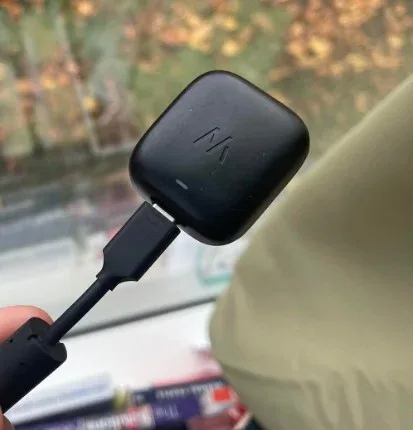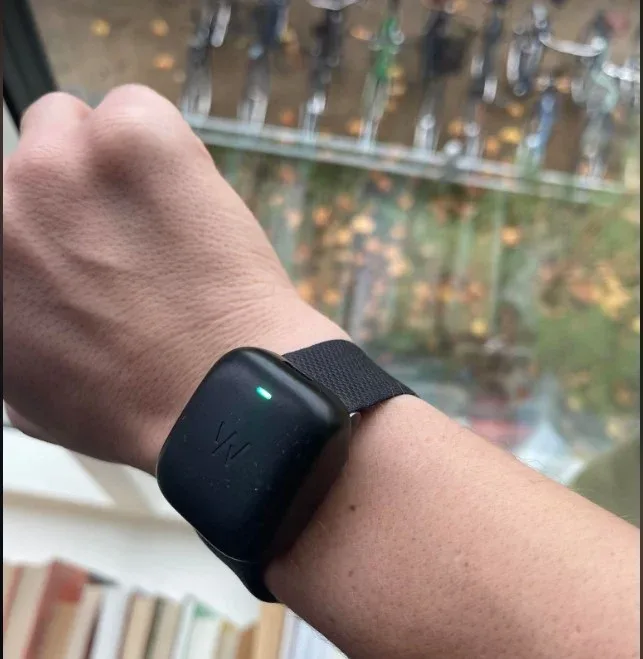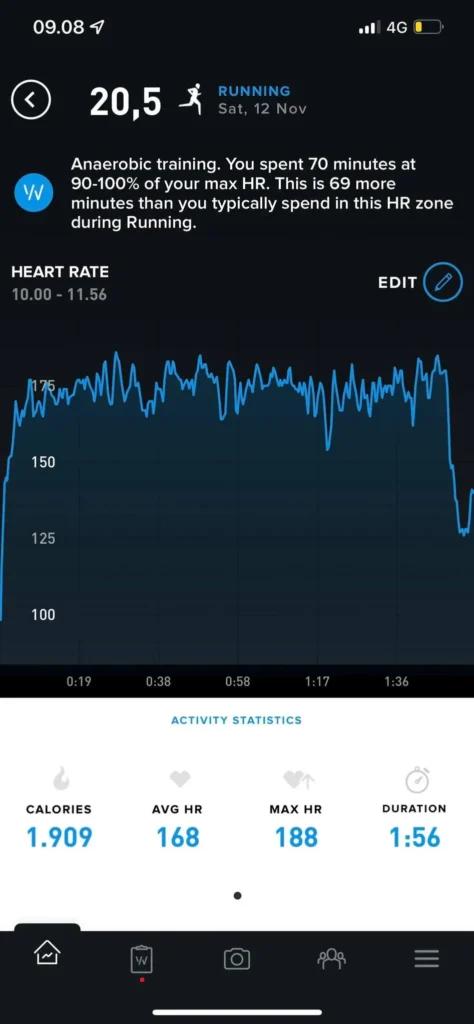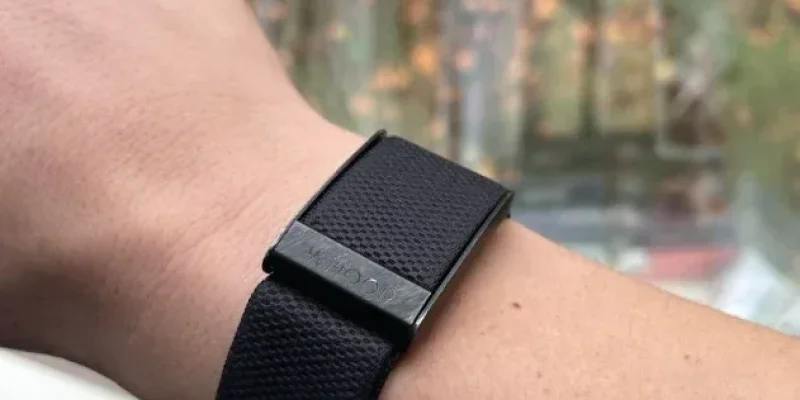I’ve tested Whoop 4.0 for 12 months. To be precise, I’ve worn the Whoop bracelet for 332 days in total, and I’ve tracked 186 different training sessions: Running, swimming, cycling, climbing, and even a 50-mile ultra-marathon. I feel comfortable saying that I’ve been thoroughly testing the Whoop 4.0. I’m not paid by Whoop to write this so it will be a 100% honest review of the product.
My review summarized
- According to a study by Central Queensland University, Whoop tracks sleep, heart rate, and heart rate variability more accurately than all other devices, including the Apple and Garmin watches.
- If you’re on a budget, I would go with Apple or Garmin; they are both great options, even though they are less accurate. Whoop is based on a subscription model, which means it will ultimately be the more expensive solution. But if you’re a data nerd like myself, it’s definitely worth the money.
- I’ve found that Whoops Battery lasts for around 5-7 days, which is excellent – and much better than Apple or Garmin watches.
- Whoops, 4.0’s weekly and monthly reports are great tools for measuring progress. To reap the benefits of the reports, you must implement changes. The data and insights you receive are significant. Act on them.
What can Whoop do?
Whoop will track: Sleep performance, Heart Rate (HR), Resting Heart Rate (RHR), Heart Rate Variability (HRV), and Respiratory Rate. All these data points a gathered in algorithms to calculate a daily strain score & recovery score, which you can use to adjust your training.
Whoop 4.0 also has a Journal function. Each day you’ll be asked a series of questions – that you choose yourself. For example, “did you follow an intermittent fasting diet?”, “did you supplement with fish oil? ” or “did you consume alcohol?”. There are tons of questions you can choose to answer.
Each month Whoop will send you a report and analyze if there are any correlations between the questions you answered and your Recovery, Sleep and strain score.
For myself, there is usually a significant correlation between a bad sleep score when and consuming alcohol the day before. My strain score is also higher when training the day after. It’s an obvious one, but it illustrates the concept quite well.
Charging Whoop 4.0
Whoops made a charger that ensures you’ll never have to take off your Whoop wristband. To be honest, it’s good. The charger works as a small portable battery you charge with a USB-C port. When your Whoop Battery is low, you’ll receive a notification on your app, and a small red LED will light up. All you have to do now is put on the small portable battery, and you can walk around with the Whoop charging. In my experience, it will take 30-75 minutes to charge it fully.


Whoop says that 20% battery capacity is enough to track a whole night of sleep. In my experience, it’s rather 15-17%. But it will depend on how long you sleep.
Whoop vs. Apple or Garmin watch
When people see my Whoop, I’m often asked: Can’t your Apple or Garmin Watch measure the same?
The short answer is partly-yes. But both Garmin and Apple still need some key features: The Whoop Journal, Weekly and monthly reports, etc. Furthermore, Whoop significantly outperforms all other devices when measuring sleep performance, heart rate, and heart rate variability.
To be honest, it’s minor differences. And sure, you can use both Garmin and Apple to measure the same things a little less accurately. If you’re on a budget, I recommend going with one of the watches. But, if you’re a dedicated data nerd like me, it’s definitely worth having Whoop collecting your data.
During exercise, I still believe that a heart rate belt is the most accurate measure. Personally, I use the Garmin HRM-tri with my Garmin Fenix 5. I’ve made reviewed on items.
If you’re interested in a more in-depth comparison, I would recommend this video:
Is WHOOP or Garmin better?
According to a study, Whoop is also better than the Garmin Watch when comparing Sleep measurement, Heart Rate, and Heart rate variability. The Whoop battery also lasts significantly longer than any Garmin Watch.
If you were to choose between Whoop and a Garmin Watch, I would choose the Garmin watch as it measures a whole lot more than Whoop does: First, it’s a GPS watch that measures run distance and elevation. But Garmin watches also measure an entire spectrum of other data points for each sport.
To compare Whoop and Garmin, I ran a half marathon trail run, wearing Whoop 4.0 and my trusted Garmin Fenix 5 – without the Heart Rate monitor bet.
– Whoop measured my average heart rate as 168 BPM. Garmin measured it at 161 BPM. Quite a big difference when measuring average heart rate. According to the before mentioned study, Whoop should be the most accurate – which, in turn doesn’t put Garmin in a good spot.
– Whoop measured my peak heart rate as 188. Garmin measured it at 187 BPM.
– Whoop estimated used calories as 1909. Garmin estimated 1555 calories. Quite a big difference.

Is WHOOP better than Apple Watch?
According to a study, Whoop is better than the Apple Watch at measuring Sleep, Heart Rate, and Heart Rate Variability. Whoop’s battery also lasts significantly longer than the Apple Watch.
Whoop is most accurate at measuring: HR, HRV, and Sleep.
According to an independent, third-party study by Central Queensland University, the Whoop wristband is 99.7% accurate when measuring heart rate and 99% accurate* in measuring heart rate variability. It’s truly remarkable as the other wristbands measured between 96-41% in heart rate and 69%-24% in heart rate variability. The study used Electrocardiogram (ESG) to measure heart rate.
When I purchased the Whoop wristband, I expected the percentages to be the most accurate – because the Whoop Wristband is significantly more expensive (over time) than the other devices tested. Furthermore, Whoops recovery algorithms use both heart rate and heart rate variability to calculate your recovery rate, and if these percentages were off, the whole concept would fall to the ground. So, it’s lovely to see that the accuracy is on point.
The study also analyzed how well the Whoops sleep measurements work. The study found that the wristband was great in identifying sleep. The method they used to measure sleep was polysomnography (PSG), which is the gold standing in measuring sleep performance – measuring both non-REM sleep and REM sleep.
The below video is a great – and scientific – review by The Quantified Scientist on Youtube.
Questions and answers about Whoop
I’ve gathered some of the most common answers to the questions I’ve gotten about my Whoop experience here down below.
Can you wear Whoop while swimming?
Yes, Whoop can be worn while you’re swimming. In fact, it can be worn down to 10 meters.
Make sure to tighten the strap more than you would normally. Especially when you’re swimming in a pool, as the water resistance when pushing off the side will mess with the positioning of your Whoop.
If you’re planning to swim open water with a wetsuit, that works perfectly fine as well. Obviously, your Whoop should be worn underneath the wetsuit.

